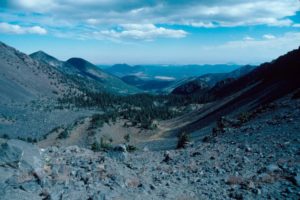 I was at about 11,000 feet when the last of the sunlight vanished. That’s where the trail grows steep and the trees begin to give out, the bristlecone pines and subalpine firs increasingly stunted and wind-sculpted.
I was at about 11,000 feet when the last of the sunlight vanished. That’s where the trail grows steep and the trees begin to give out, the bristlecone pines and subalpine firs increasingly stunted and wind-sculpted.
That’s also the elevation where I always feel the thinning atmosphere, and have to stop more often to pant. But from here there was no way down but up.
Traversing the Peaks, alone, at night, had seemed a good idea back in town. Why do the same thing as all the day hikers from Phoenix? I wanted the night to turn a familiar landscape into a novel one. Now, as the darkness in fact gathered, I had to face the reality that I had something like 20 miles to cover alone. Two miles above sea level, what had been a lark when I talked about it in town now seemed a long, dark trudge.
It was the end of September, just before the aspens began to turn. The last orange and salmon disappeared from the cinder cones and forest meadows to the west, and I continued on up. At 11,800 feet I reached the saddle where the trail split. The left wound through cinders and coruscated lava up to the unseen summit of Mount Humphreys. The trail to the right continued upslope too, to the place where it joined the old Weatherford route. I’d picked the Weatherford because it was designed as a toll road that would take cars to the summit. With the onset of the Great Depression, the project went bust, but not before J.W. Weatherford had completed miles of gentle switchbacks that climbed to within about two miles of the Humphreys summit. Broad and not too steep, it was a route I figured I could find and follow under the light of the full moon.
Having timed this all carefully, I’d expected to be greeted at the saddle by the full moon low over the Painted Desert. Imagine my surprise, then, when I crested the rise to find the entire eastern sky hidden behind clouds, and a wind blowing from the east that carried the scent of rain. Only later did I find out that these were the remnants of a hurricane that had blown north from Mexico.
I should mention here that untoward things always happen to me high in the Peaks. The air is thin and the wind always blows. The lava is jagged and it’s too high and cold for trees and the place is sacred to the Navajos and the Hopis, who believe that the kachinas dwell up here. I’ve had enough unexpected things happen to me up there that I can well believe it: headaches, stumbles, sudden storms, odd winds. It’s not a place to approach casually. Each time I go up there I have to learn this anew.
I felt the first drops of rain just as I reached the old Weatherford auto route’s highest point. They were slight but wind-blown, and I was nervous about the prospect of being up in the heights with no shelter and an unreliable knee and all the night long to hike. But this is what I was looking for, I thought, wanting to be unlike all those daytime hikers. Now it’s just me and the wind and the rain and the kachinas.
From near the peak of Mount Agassiz the Weatherford Trail winds down slowly toward Doyle Saddle. East and west I could see headlights strung out like pearls along I-40. But they were a long way off. It proved a long haul down the old switchbacks, grown bumpy over the decades: I stumbled a lot over small rocks whose height I couldn’t quite discern in the dark. Rest, snack, water: the night went on with scant change to the dim light. The moon stayed hidden behind the stubborn clouds.
But it’s funny what can give you hope. At home we lived a few blocks from the tracks and the nights, especially, were punctuated with their startling whistles, a damn-that-just-woke-me-up-again slap in the dark, often, when I was having trouble chasing sleep. But up here—well, let’s just say that one of the best parts of the hike came when I neared Doyle Saddle, with still a long way to go winding down the trail and then miles through the flatter parts of the forest all the way back to town, and the clouds seemed to me to be broken not by clear sky but by a small tender sound, a tiny knife point applied to the overcast: toot, toot! The train, far off, but indisputable. At home it was the sound of restless irritation. Up here, all alone on the mountain, it was the sound of home, period. I felt energized by it.
Sure enough, it was not long before the overcast began to drift apart into moonlit fragments. I hiked down the lower part of the Weatherford, the weird gruntings and boomings of elk seeming very near me in the dark forest all around. By the time I neared Schultz Tank the ponderosa woods themselves were moonbright, an elven landscape of dark trunks and pale grass. An owl hooted.
I still had weary miles to go, winding my way back along Schultz Creek and then through the patchwork of trails and meadows that comprised my daytime running route. In town, the building that houses the ice rink hummed loudly. The train was a real presence now, not just its whistle but the diesel engines a visceral presence. I wound my way back home through the empty streets, reaching the house in the predawn darkness. And for the next few days hearing the train horns wasn’t a bother at all.

